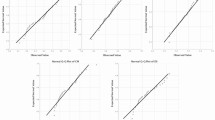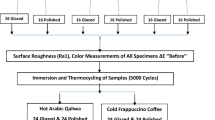Abstract
Ceramic restorations have been widely used in dentistry. These restorations often require intraoral adjustment with diamond burs after their cementation causing increasing roughness of the ceramic surface. Consequently some finishing and polishing methods have been used to minimize this occurrence. The aim of this study is to evaluate the roughness of the ceramic surfaces submitted to different finishing and polishing methods. 144 specimens of VITAVM®7, VM®9 and VM®13 (VITA Zahnfabrik) ceramics were fabricated and submitted to grinding using diamond burs. They were then divided into 15 groups (five of each ceramic type). Groups 1, 6 and 11—positive control (Glaze); Groups 2, 7 and 12—negative control (no polishing); Groups 3, 8 and 13—polished with abrasive rubbers (Edenta), felt disc and diamond polishing past; Groups 4, 9 and 14—polished with abrasive rubbers (Shofu), felt disc and diamond polishing past; Groups 5, 10 and 15—polished with aluminum oxide discs (Sof-Lex, 3M-ESPE), felt disc and diamond polishing paste. The roughness of the samples surfaces were measured using the rugosimeter Surfcorder SE 1700 and the data were submitted to statistical analysis using ANOVA and Tukey test at a level of significance of 5 %. There was statistically significance difference between the positive control groups and the other groups in all the ceramic types. Mechanical finishing and polishing methods were not able to provide a surface as smooth as the glazed surface for the tested ceramics. To assist dental practitioners to select the best finishing and polishing methods for the final adjustment of the ceramic restorations.


Similar content being viewed by others
References
Yilmaz C, Korkmaz T, Demirköprulu H, Ergün G, Özkan Y (2008) Color stability of glazed and polished dental porcelains. J Prosthodont 17:20–24
Metzer KT, Woody RD, Miller AW (1999) In vitro investigation of the wear of human enamel by dental porcelain. J Prosthet Dent 81:356–364
Klausner LH, Cartwright CB, Charbeneau GT (1982) Polished versus autoglazed porcelain surfaces. J Prosthet Dent 47:157–162
Karaksi AOE, Shehab GI, Eskander ME (1993) Effect of reglazing and of polishing on the surface roughness of new ceramic restoration (Hi Ceran). Egypt Dent J 39:485–490
Camacho GB, Vinha D, Panzeri H, Nonaka T, Gonçalves M (2006) Surface roughness of a dental ceramic after polishing with different vehicles and diamond pastes. Braz Dent J 17:191–194
Bessing C, Wiktorsson A (1983) Comparison of two different methods of polishing porcelain. Scand J Dent Res 91:482–487
Oliveira MCS, Santos GAG, Siqueira DVS, Vieira AC, Oliveira VMB (2010) Qualitative evaluation of the surface roughness of a dental porcelain after three different polishing systems. Odontol Clin-Cient 9:151–154
Al-Wahadni A, Martin M (1998) Glazing and finishing dental porcelain: a literature review. J Can Dent Assoc 64:580–583
Benetti AR, Miranda CB, Ramos L Jr (2002) Avaliação da porosidade superficial da porcelana submetida a diferentes métodos de acabamento e polimento. PCL 4:489–493
Barghi N, King CJ, Draughn RA (1975) A study of porcelain surfaces as utilized in fixed prosthodontics. J Prosthet Dent 34:314–319
Sarac D, Sarac YS, Yuzbasiogl E, Bal S (2006) The effects of porcelain polishing systems on the color and surface texture of feldspathic porcelain. J Prosthet Dent 96:122–128
Gomis JM, Bizar J, Anglada JM, Samsó J, Peraire M (2003) Comparative evaluation of four finishing systems on one ceramic surface. Int J Prosthodont 16:74–77
Patterson CJW, McLundie AC, Stirrups DR, Taylor WG (1992) Efficacy of a porcelain refinishing system in restoring surface finish after grinding with fine and extra-fine diamond burs. J Prosthet Dent 68:402–406
McPhee ER (1985) Extrinsic coloration of ceramometal restorations. Dent Clin North Am 29:645–666
Ward MT, Tate WH, Powers JM (1990) Surface roughness of opalescent porcelains after polishing. Oper Dent 20:106–110
Nakazato T, Takahashi H, Yamamoto M, Nishimura F, Kurosaki N (1999) Effect of polishing on cyclic fatigue strength of CAD/CAM ceramics. Dent Mater J 18:395–402
Hulterström AK, Bergman M (1993) Polishing systems for dental ceramics. Acta Odontol Scand 51:229–234
Chu FCS, Frankel N, Smales RJ (2000) Surface roughness and flexural strength of self-glazed, polished, and reglazed in-ceram/vitadur Alpha porcelain laminates. Int J Prosthodont 13:66–71
Netto Júnior BA, Inoue RT, Ribeiro FC, Feltrin PP (2006) Estudo da rugosidade das superfícies metálica e porcelana mediante acabamento e polimento com sistemas de borrachas para polimento. Revista de Odontologia da UFES 8:6–18
Patterson CJW, McLundie AC, Stirrups DR, Taylor WG (1991) Refinishig of porcelain by using a refinishig kit. J Prosthet Dent 65:383–388
Al-Wahadni A (2006) An in vitro investigation into the surface roughness of 2 glazed, unglazed, and refinished ceramic materials. Quintessence Int 37:311–317
Kelly JA, Nishimura I, Campbell SD (1996) Ceramics in dentistry: historical roots and current perspectives. J Prosthet Dent 75:18–38
Wright MD, Masri R, Driscoll CF, Romberg E, Thompson CGA, Runyan CD (2004) Comparison of three systems for the polishing of an ultra-low fusing dental porcelain. J Prosthet Dent 92:486–490
Hoelscher DC, Neme AML, Pink FE, Hughes PJ (1998) The effect of three finishing systems on four esthetic restorative materials. Oper Dent 23:36–42
Raimondo RL Jr, Richardson JT, Wiedner B (1990) Polished versus autoglazed dental porcelain. J Prosthet Dent 64:553–557
Oliveira AB, Matson E, Marques MM (2006) The effect of glazed and polished ceramics on human enamel wear. Quintessence Int 19:547–548
Ancowitz IS, Torres T, Rostami H (1998) Texturing and polishing. Dent Clin North Am 2:607–612
Jung M (2002) Finishing and polishing of a hybrid composite and a heat-pressed glass ceramic. Oper Dentist 27:175–183
Author information
Authors and Affiliations
Corresponding author
Rights and permissions
About this article
Cite this article
Vieira, A.C., Oliveira, M.C.S., Lima, E.M.C.X. et al. Evaluation of the Surface Roughness in Dental Ceramics Submitted to Different Finishing and Polishing Methods. J Indian Prosthodont Soc 13, 290–295 (2013). https://doi.org/10.1007/s13191-013-0261-y
Received:
Accepted:
Published:
Issue Date:
DOI: https://doi.org/10.1007/s13191-013-0261-y




